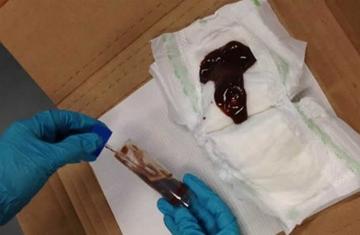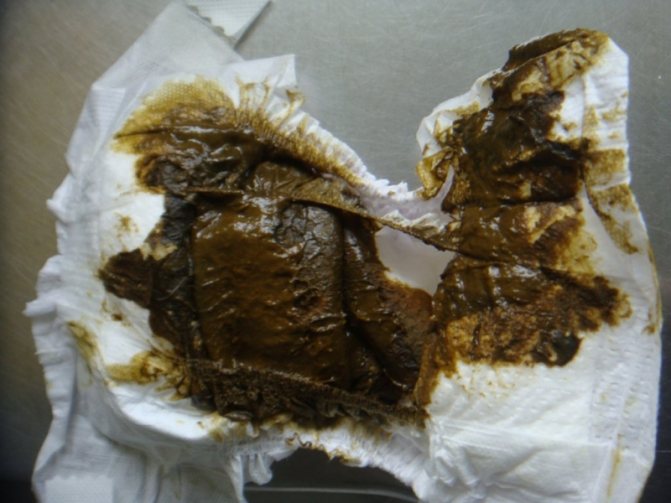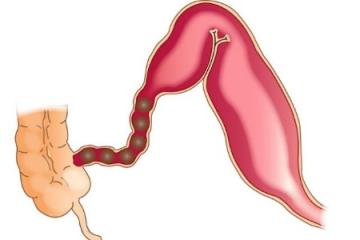Parents are concerned that their newborn baby will be healthy, feel good and develop properly.
Young and inexperienced mothers often do not know what condition of the baby is normal. In order to detect any deviations in time, you need to know how specific physiological processes occur in the baby’s body.
It is common for newly born babies to pass meconium. This is the first bowel movement. It is necessary to understand how many days a newborn has meconium, and what to do in case of delay.
Meconium: what is it?

Meconium may contain digested epithelial cells, bile fragments, amniotic fluid, perinatal hair, mucus, and amniotic fluid. The color of the stool varies from dark green to black. Meconium has very different characteristics from regular feces.
It is almost odorless, viscous and sticky. A newborn has about 60-100 grams of meconium. The acidity of original feces is 6 pH. Babies usually do not pass meconium in utero. Original feces are passed for some time after delivery. But there are situations when meconium enters the amniotic fluid.
If it is released in small quantities, it does not cause any harm. If there is a lot of meconium, it blocks the lumen of the bronchi when it enters the lungs. This condition is called aspiration syndrome in pediatrics. It is typical for full-term and post-term babies and has a significant likelihood of mortality.
During hypoxia, during childbirth, the baby begins to defecate more often. Meconium enters the amniotic fluid. After the baby is born, doctors clean his lungs using a special device.
It is generally accepted that meconium is completely sterile. In the first hours after birth, the intestines are populated with beneficial bacteria. But recently, Spanish scientists have refuted this opinion. Doctors have proven that original feces contain lactobacilli and some intestinal microorganisms.
Video on the topic
About newborn stool in the video:
Thus, in the first two days after birth, babies should pass meconium. If stool is not passed, you should consult a doctor. A delay can lead to serious complications, including death.
When preparing for childbirth, it is important for all expectant mothers to know what color newborns usually have, where it comes from, and why it is needed. The appearance of a dark sticky mass in a baby’s diaper is a good sign, which indicates that the baby’s intestines have begun to function properly.

Meconium in a newborn's diaper
How long does it take?

On the second or third day, bowel movements are called transitional: they contain the remains of meconium and digested food. First, streaks and impurities are visible in the feces.
But gradually the feces become mushy and homogeneous. A baby's normal stool is yellow and runny.
Reasons for delay
Doctors talk about meconium retention if the original feces are not passed in the first 24 hours of the baby’s life. This condition indicates the presence of a pathology of the digestive tract and is very dangerous for the baby.
The main causes of meconium retention:
- congenital anomalies of the intestinal tract , which lead to obstruction. Such defects include atresia of a section of the large or small intestine, anus, the presence of a membrane in the duodenum, and an annular pancreas. Such pathologies usually develop against the background of chromosomal abnormalities and defects of other internal organs;
- Hirschsprung's disease . This is a congenital pathology. It is characterized by the absence or underdevelopment of the intestinal nerve plexuses that regulate its motility. This condition leads to obstruction of the affected area. Parts of the intestine become overfilled with feces and expand;
- immaturity of the function of the digestive tract organs . This condition is typical for premature babies. A decrease in secretion and intestinal motility causes fecal stagnation;
- cystic fibrosis . This is a multiorgan severe disease that is inherited in an autosomal recessive manner. With cystic fibrosis, pancreatic secretions become viscous. The organ does not produce enough enzymes. Absorption of fluid from the intestinal lumen increases. With such a deviation, the consistency and discharge of original feces change;
- meconium plug syndrome . It is observed when there is an accumulation of original feces in the large intestine. Occurs due to impaired motor function of the organ. Meconium plug syndrome is typical for children born to mothers diagnosed with hypermagnesemia or diabetes mellitus.
Where do green waters come from?
The appearance of amniotic fluid is directly related to the condition of the maternal and child organisms. Therefore, a change in the color of the water or its cloudiness is an alarming signal for medical personnel and a sign, and if the child has swallowed green amniotic fluid, urgent action is required.
Darkening of the waters is often encountered in obstetric practice. You shouldn’t immediately start panicking if the doctor told you about this, because the reasons for changes in the color of the amniotic fluid can be different and do not always pose a serious threat to the baby’s condition. In addition, this phenomenon has not yet been fully studied by the medical scientific community.
The reasons why amniotic fluid turns green are as follows:
- Passage of meconium. In a third of cases when darkening of the waters is observed, this is due to the fact that the baby, while still in the mother’s womb, empties its intestines, although this usually happens 1-2 days after birth. It is the original feces that gives the green color to the waters.
- Hypoxia. Due to the aging of the placenta, during pregnancy the baby may not have enough oxygen to breathe.
- Infection. If a woman suffers from a cold or other infectious disease while expecting a baby, this can cause infection of the amniotic fluid.
- Genetic disorder. Congenital pathologies of the fetus often contribute to the coloration of water.
- Nutrition. There is a hypothesis that green food eaten the day before can change the color of the amniotic fluid, but this statement has no official confirmation.
Meconium ileus

The disease is quite rare: it occurs in one newborn out of 10,000-16,000 children. In most cases (about 75%), meconium ileus is caused by cystic fibrosis and small intestinal atresia. This condition is often observed in premature babies.
Meconium ileus was first described by Landsteiner in 1905. Intestinal obstruction can be eliminated in approximately 85% of cases. However, complete recovery is impossible to achieve, since cystic fibrosis is a genetic pathology. Half of babies with this disease die before one year of age.
According to statistics, about 15% of babies with cystic fibrosis suffered from meconium ileus in infancy.
Causes and symptoms

As a result, feces stick to the mucous membranes and cannot come out. Intestinal obstruction occurs in the baby while still in the womb. Other changes in the intestinal tract are also diagnosed.
For example, the lumen of the excretory ducts of the mucous glands expands, and the membrane atrophies. The intestinal loops located distal to the site of obstruction are almost completely devoid of feces and are reduced in size. This phenomenon is called microcolon in medicine. Symptoms of meconium ileus appear in the first two days of a baby's life.
The main sign of pathology is the absence of bowel movements within 24-48 hours after birth. On the second or third day, the child’s condition begins to deteriorate. The baby becomes restless and whiny. He loses his appetite and sleep is disturbed. There is frequent regurgitation. Vomit contains admixtures of feces and bile.
As the disease progresses, the following symptoms are added:

- bloating;
- decreased turgor of the epidermal integument;
- pale skin;
- apathy;
- inactivity.
Further signs of dehydration and intoxication are added:
- increased heart rate;
- increased blood pressure;
- pronounced thirst;
- increase in body temperature;
- dry skin.
Often, children with meconium ileus experience complications such as bronchitis or pneumonia. In half of the babies, the disease causes the development of intestinal perforation and incomplete rotation of the organ. This is due to the inversion of weakened, stretched loops, the formation of a pseudovalve, and deterioration of the blood supply to the walls of the digestive organs.
With prolonged ischemia, intestinal infarction, pseudocystosis, and meconium peritonitis are possible. If signs of ileus appear, you should immediately call the doctor on duty. The sooner therapy is selected, the higher the chances of saving the child.
Treatment approaches
The treatment of meconium ileus must be approached competently and responsibly.
Medicinal and surgical methods of therapy are used. The choice of method is made based on the severity of the newborn’s condition. To liquefy and stimulate the passage of feces, the child is given an enema with a warm solution of sodium chloride and gastrografin. In uncomplicated cases, about 2-3 such procedures are required. Gastric decompression is performed, during which the organ cavity is cleaned with a nasogastric tube.
Infusion therapy is effective. Its essence lies in the introduction of electrolytic, nutritional solutions. Droppers are placed a couple of days after intestinal patency is restored. If cystic fibrosis is present, enzyme medications must be included in the treatment regimen.
In case of severe ileus and ineffectiveness of conservative therapy, surgery is performed. The purpose of surgery is to evacuate meconium and restore intestinal patency.











